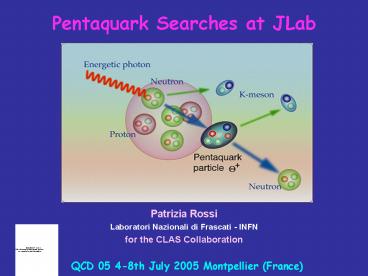Pentaquark Searches at JLab PowerPoint PPT Presentation
1 / 20
Title: Pentaquark Searches at JLab
1
Pentaquark Searches at JLab
Patrizia Rossi Laboratori Nazionali di Frascati -
INFN for the CLAS Collaboration
QCD 05 4-8th July 2005 Montpellier (France)
2
Goal of the Experimental Pentaquarks Program _at_
JLab
The goal of the experimental pentaquark program
at Jefferson Lab is to have a comprehensive
program to search for pentaquarks with high
statistics and high resolution photoproduction
experiments.
New experiments seeking evidence of pentaquarks
with the CLAS detector in Hall B were approved in
2003-2004 with the goal of confirming previous
results and explore new kinematics with at least
a factor 10 increase in statistics
g10 deuteron Eg 1.0-3.5 GeV
data taking completed in 2004 g11 proton
Eg 1.6-3.8 GeV data taking
completed in 2004 eg3 deuteron Eg
4.0-5.4 GeV data taking completed in
2005 Super-g proton Eg 3.8 5.7
GeV planned for 2006
3
Hall B Cebaf Large Acceptance Spectrometer
Tagger
- Broad angular coverage
- (8 ? 140 in LAB frame)
- Charged particle momentum
- resolution 0.5 forward dir
- Tagged photon beam with
- energy resolution dk/k 0.1
- Eg (20 - 95) Ee
4
G11 Spettroscopy of Exotic baryon with
CLASSearch for Ground and Excited States
Proposed measurement and Primary Goals Search
for ?(1540) and possible excited states in ?-p
interaction above threshold (E?1.6 3.8 GeV)
- collect more than 10 times the statistics of
previous - measurements
- establish the mass of any observed peak with 2
MeV accuracy - determine total and differential cross section
- Status of the experiment
- New experiment approved by JLab PAC25 in January
2004. - Run in May-July 2004, with a total of 7109
triggers recorded (Luminosity 70 pb-1) - Data calibration and processing completed in
January 2005this reaction
5
G11 Channel Identification
- strangeness is tagged detecting the K
- the K0 is detected via its KS component decaying
- into ?????? ?
- final state is identified using the missing mass
technique - hyperons which give the same final state are
removed (?(1520), ?, ?-) - using the full statistics (70 pb-1) 165000
events selected
6
G11 nK Mass Spectrum
- the nK mass spectrum is smooth
7
G11 Evaluation of an Upper Limit on the Q
X-Section
8
G11 Upper Limit on the g p ? Q K0 Cross
Section
N(95 CL) derived using Feldman and Cousins
approach
Upper limit (95 CL) ????p ?????K0 lt 1-4 nb
9
G11 Comparison with SAPHIR results
SAPHIR
Counts
Counts
- Kinematics
- Energy limited to
- 2.6 GeV
- no hyperon rejection
- Selection of forward
- angles of the K0 in
- the ?-p center of mass
K0
cos?CM(K0) gt 0.5
?
M(nK) (GeV)
M(nK0) (GeV)
g11_at_CLAS
Counts
Counts
?(1520)
?(1540) ?
M(nK0) (GeV)
M(nK) (GeV)
10
G11 Comparison with SAPHIR results
SAPHIR
Counts
Counts
K0
cos?CM(K0) gt 0.5
?
M(nK) (GeV)
M(nK0) (GeV)
g11_at_CLAS
Counts
Counts
?(1520)
?(1540) ?
M(nK0) (GeV)
M(nK) (GeV)
11
G10 Search for T on Deuterium
Proposed measurement and Primary Goals Search
for ?(1540) in ?-d interaction in the energy
range E? 0.8 3.59 GeV
- Collected data with two values of the CLAS torus
magnetic field - For each configuration collected data with 10
times the statistics of the published result - Determine total and differential cross section
- Status of the experiment
- Run in May-July 2004, with a total luminosity of
50 pb-1 - Indipendent analysis of several reactions by
different groups reaction
?d?nKK-p T?nK ?d?pK0 K-(p)
T?pK0 K0???- ?d??Kn T?nK
?? p?- ?d??K0p T?pK0 ?? p?-
K0???-
12
G10 Comparison with Published Data (g2a)
13
G10 Comparison with Published Data
- Published results on Q from analysis of g2a data
cannot be reproduced in the analysis of high
statistics g10 data - The statistical significance in the published
data is an unlucky coincidence of the statistical
fluctuation and the underestimate of the
background in the mass region of 1.54 GeV/c2.
14
G10 Upper Limit on X-section for gd?QpK-,
Ppgt0.35 GeV/c
No peak is found under minimal kinematical cuts
- Fit with the sum of 3rd degree polynomial and a
Gaussian function with fixed width. Gaussian
s5.5 MeV/c2, mean running from 1.48 to 1.72
GeV/c2 .
Number of signal events number of events
fluctuating into Gaussian peak - Acceptance calculation 4 body phase space event
generator, modified to match kinematics of
detected particles with data
15
G10 Upper Limit on X-section for gd?QpK-,
Ppgt0.35 GeV/c
16
G10 Upper limit on the elementary cross section
gn?QK-
17
G10 Upper limit on the elementary cross section
gn?QK-
- With Fermi momentum being the only source of an
energetic spectator proton, the cross section
upper limit is 20 nb _at_ M(nK)1.529 GeV - If we assume a more sophisticated model for an
energetic spectator and take the ?(1520)
production as a guide, the cross section upper
limit is 4-5 nb _at_ M(nK)1.529 GeV(model
dependent).
18
Conclusion
19
Conclusion (contd)
20
Conclusion (contd)
- A clear peak is seen in the pK and pK-
- invariant mass distribution in dAU coll.
- _at_ 200 GeV and AuAu coll. _at_ 62.4 GeV.
- No signal is seen in pp coll. _at_ 200 GeV.
- The peak mass is 1530 MeV, width 15 MeV

